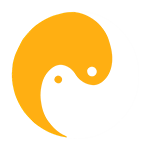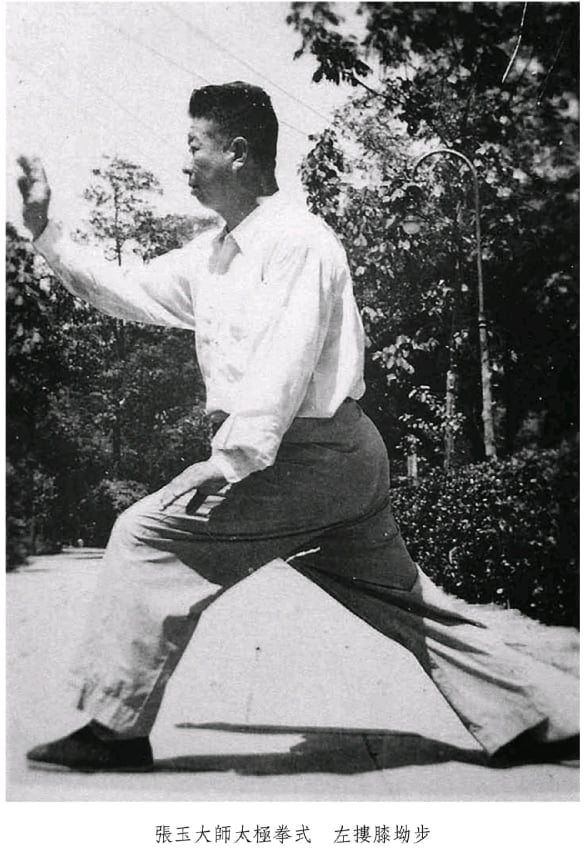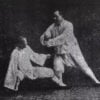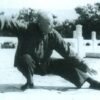Photo: Master Zhang Yu, a lineage holder of Grandmaster Wu Huichuan, one of the top students of Master Yang Chengfu, who was one of the Heng-Ha generals of the Yang family and one of five tiger generals of the Yang family.
Article: Huang Renliang, a student of Master Zhang Yu.
Most boxing (Taijiquan) practitioners believe that Gong Bu (Bow stance) uses the back leg to push (Deng) forward; the front leg bends and becomes Gong Bu, known as “Push the back leg and bend the front leg.” When I first started learning Taijiquan, I learned the simplified version of Taijiquan and the 88 movements form. All Gong Bu uses the back leg to push forward and bend the front leg. So, usually, even when we finish the Gong Bu, the rear leg is still pushed backward, especially when trained on a slippery floor.
After I started studying with master Zhang Yu (a lineage holder of GM Wu Huichuan, a top student of Yang Chengfu, and one of the Heng-Ha Generals of the Yang family), my boxing frame was corrected, I realized that Gong Bu is not using force pushing forward. It uses Yao-Kua turning and Song Chen to the front leg. Also, the back leg is not using force at all. My master said, “under the feet has to be stable, so it has a root.”, the root is created down to the ground, not by a horizontal force pushing upward.
In training boxing, one must use Yao (waist) lead feet, not using feet to push Yao. So, every time doing Gong Bu, one must keep in mind that Yao is the commander, and whatever the full or empty legs, they must be stable. To train for stability under the feet, I used to practice the form on a slippy floor and even with straw and sand on the floor, to make it even more slippy under my feet.
The principle of “using Yi, not force” in Taijiquan is applied to the whole body, including lifting, sinking, shifting the weight forward, and sitting backward. So, those “pushing the back leg to bend the front leg.” sure are using force with intent. The vital principle of “Using Yi to lead the waist, using the waist to lead the feet” has been abandoned.
The movements in Taijiquan have Yao as the commander; all outward movements depend entirely on the waist. It is using Yao to lead feet, not using feet to push (Deng) the Yao. Using feet to push the Yao, one must be heavy: using Yao leads feet, one must be light and agile.
Some boxing friends used to train those incorrect methods, influenced by the practice of “push back legs, bent front legs” is quite deep. Even after switching to the Yang Family’s Taijiquan training, under their feet still exert too much force. There is a saying that “stepping like a walking cat” means a cat walking is light. If you apply pressure on your feet, how can you be light?




I’ve been writing about this for some time but most players do not want to hear it. We were trained that you do not push with your feet. Rather, you pull, like a cat. But with more experience I’ve learned that even pulling is not exactly correct. When going into Gong Bu let the kua sink as if to the floor, and the same when moving back. The sinking shifts the weight and the legs and feet stay relaxed with a much deeper root. The term “pulling” has changed to “absorbing” as if pulling something out of the ground.
Thanks for making this point, something I’ve thought about as well.
Yes, pulling also a mistake. I think what happens is that, say going from xu bu to gongbu, if you keep sinking to the back leg, there will be a reaction that causes the front leg to bend and your weight to move forward. But this action is passive and not pulling with the front leg
when Yang Zhen Duo taught a week long seminar in USA about 1989, he said gong bu is push forward with back leg, and push backward with front leg. fwiw.
I cannot rate this article highly enough, thanks to Liang Dehua for translating and sharing. As far as I’m concerned the average player straightens the back leg and with a lunge towards the front foot combined with a push with hands/arms with varying degrees of subtlety, or just a gross shove. The above article is everything the previous sentence is not. Check out late last century masters like Huang Sheng Shyan (Yang Style) and Ma Yueh Liang of Wu Style on You Tube demonstrating the above highly refined principles and more from decades of research and practise.
There is something coming up from the back foot. THere’s a video online where Huang talks about the jin coming up from the back foot
https://www.youtube.com/watch?v=56RsIW2ExxI&t=28s appears to be doing things opposite of the article. any thoughts or comments. btw, this is the guy pnut just pushed with in Florida and posted a video.
I think 80% of practitioners oppose the principle in this article. Which is no problem; everyone can train in their way.
Yes, most people seem not to notice. The classics are precise and the opposite of what most people are doing. You show us the correct way in your videos..! Thank you. It works so much better with the Yao. 😉